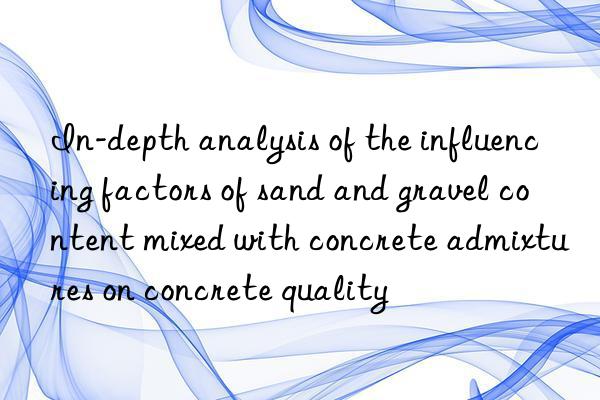
The high content of sand and gravel has always been a headache during construction. Due to the large content, it seriously affects the quality of concrete buildings. According to research, through the analysis of the composition of the physical and chemical components of clay and its adsorption capacity of polycarboxylate admixtures, and combined with practical demonstrations, the influence of the mud content of sand and gravel on the quality of concrete mixed with polycarboxylate admixtures is proposed. The insights provide a feasible technical route for the production of ready-mixed concrete enterprises.
In fact, the chemical reactions of concrete composition are very complex. In addition to the normal silicate hydration reaction, the addition of mineral powder and fly ash also adds many highlights to the research on concrete, but What troubles many concrete scholars is that due to the clay brought into the concrete sand and gravel raw materials, quality problems such as reduced initial fluidity, increased shrinkage cracks, and reduced durability of concrete have emerged one after another, and it is also difficult to control. This article focuses on the mud content of sand and gravel. The influence of concrete quality mixed with polycarboxylate admixtures is discussed.
The effect of sand and gravel mud content on the quality of concrete mixed with polycarboxylate admixtures
1) The effect of sand and gravel mud content on the workability of concrete mixed with polycarboxylate admixtures Influence.
In order to truly reflect the impact of different mud contents of sand and gravel on the workability of concrete mixed with polycarboxylate admixtures, C30 concrete is now used as an example to conduct a concrete mixture workability test.
Cement: Shanxi Shuangliang Dingxin Cement Co., Ltd. produces P.O42.5 grade cement, with a specific surface area of 389, SO3 content of 2.1%, and a 3d compressive strength of 25.8MPa.
Mineral powder: S95 grade mineral powder produced by Shanxi Zhongke, with a specific surface area of 420.
Fly ash: Taiyuan No. 2 Power Plant grade fly ash, fineness 3%.
Sand: Xinzhou Douluo water-washed sand, with a mud content of 1.5% and a fineness modulus of 2.6. Wash it again until the mud content is 0.1%, and dry it in the sun for later use.
Crushed stone: Yangqu County limestone gravel, particle gradation 2mm ~ 25mm, continuous particle size.
Admixture: HS-109 polycarboxylate water-reducing agent produced by Shanxi Heshengbang Concrete Building Materials Co., Ltd. has a solid content of 40%. Add an appropriate amount of slump retaining agent to it and dilute it to a solid content of 8.0%. Pumping agent, dosage 2%.
Water: Drinking water.
Clay: chemical filler bentonite, fineness 200 mesh, SiO2 content 54%, Al2O3 content 18%.
Mix clay into concrete at a rate of 1% to 9% instead of washed sand. Adjust the amount of admixtures to ensure that the concrete slump is within the design range. Check the fluidity and viscosity of the concrete mixture. Changes in polymerization and water retention
As the mud content increases, the workability of the concrete mixture becomes worse and worse, the bulk density becomes smaller and smaller, and the amount of admixtures becomes larger and larger. , obvious changes occur after the mud content exceeds 3%. After 7%, the concrete undergoes qualitative changes, and the overall concrete becomes weak. Increasing the amount of admixtures cannot change the fluidity of the concrete, and the concrete becomes virtual ash and dead ash. Not workable or pumpable.
2) The effect of sand and gravel mud content on the strength and durability of concrete mixed with polycarboxylate admixtures.
The clay contained in sand and gravel affects the mixing and workability of concrete because it is porous, absorbs water, and adsorbs admixtures. If the quality of the concrete is not considered, sand with a mud content greater than 3% will be When stone is used in concrete, the water consumption will increase, the amount of admixtures will increase, and the bulk density of concrete will decrease. If the mud content is greater than 7%, the mechanical properties and durability of concrete will undergo fundamental changes.
As the mud content increases, the amount of admixture added increases, and the strength of the concrete decreases. When the mud content exceeds 4%, the 28d strength has dropped to less than 30MPa, and a large number of pores appear on the surface of the concrete. The density is greatly reduced, and the result is that the durability of the concrete is greatly reduced, and the concrete cannot meet the functional requirements.
</p

 微信扫一扫打赏
微信扫一扫打赏

